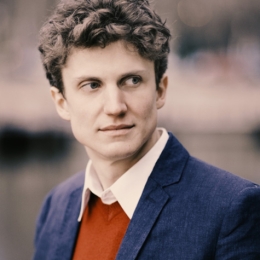Story lines: ISO under Markus Stenz invites discovery
 | |
| Fejérvári masters countryman's last concerto | . |
But just as we can be reminded that the tomato is botanically a fruit, we prepare it and eat it and taste it as a vegetable. Similarly, the percussive character of the piano is just one aspect of its sound and aesthetic. Its lyricism is well-established, and piano technique is well-grounded in sostenuto expression, ways of counteracting the inevitable decay of each tone. With Debussy, the idea of the "piano without hammers" is put forward, in contrast to Bartok's provocative early works for piano, such as "Allegro barbaro" (1911), which stressed the instrument's striking nature.
The nuances of Bartok's approach, especially late in life, embraced the lyrical side as well. That was evident in Fejérvári's performance of the Third Piano Concerto with the ISO Friday night. The recurrent mellowness is clearly influenced by the Hungarian composer's devotion to his wife, Ditta, as well as to his occasional access to optimism despite his generally miserable time of exile in the United States, where he would die of leukemia in 1945.
Bartok's reputation has been somewhat hurt in modernist circles by what is seen as a retreat from the asperities of "The Miraculous Mandarin" and the subtle innovations of "Music for Strings, Percussion and Celesta." Despite the evident popularity to this day of the Concerto for Orchestra (1945), doctrinaire believers in music's necessary "advancement" have clucked their tongues at late Bartok. Did he yield to a failure of nerve? Well, only if you maintain creative artists have a duty to press forward according to somebody else's idea of progress.
Yang, the ISO's assistant conductor, found agreement right away with the pianist and the conversation's
 |
| Poised hands: German conductor Markus Stenz |
other participant, guest conductor Markus Stenz, when he noted the score's exquisite balance of solo instrument and orchestra. That proved to be the case in the performance, with its flawless rapport. The way accents are distributed in the second movement got graceful representation in this performance. The evocation of bird song amounted to radiant twittering (if the word "twitter" has not been permanently spoiled).
Fejérvári's native sense of what Bartok drew upon from Hungarian music was immediately conveyed: His articulation of the first movement's main material evoked the cimbalom. More pianistic passage work in the middle drew upon the Liszt legacy. The finale put a handsome crest of dash and savoir-faire upon what Bartok's late mastery was able to attain. Modernism was not abandoned, just further personalized by a composer who, while not exactly short-lived, probably had much more to offer. The substantially youthful audience's ovation elicited a tender encore, the third movement of Leos Janacek's "In a Mist."
The program opened with a dramatically well-shaped performance of Beethoven's Leonore Overture No. 3, the most often heard in concert of the four written for the opera "Fidelio" (which by the way the Indianapolis Chamber Orchestra will present semi-staged on May 13). The huge diminuendo before the fast main section was practically a coup de théâtre all by itself. The decision to have principal trumpet Conrad Jones utter the first of the famous "rescue" fanfares remotely from near the side balcony, and the second up close into the hall, was further justified by the excellence of his delivery. The final acceleration of tempo had ensemble stature as well as motoric excitement.
With Schumann's Symphony No. 2 in C major, Stenz justified his injunction to the preconcert audience to hear the program as part of the post-pandemic triumph of "live" performance. The triumphant note was approached judiciously, and made this piece come across as some of the healthiest music Schumann ever wrote. There was more clarity and timbral variety than one often hears in the symphonic works of a composer excessively criticized for muddiness of orchestration. The extra burble at the start of the first Trio in the Scherzo was no more disturbing than the burst of froth you might get when you open a slightly unsettled can of beer.
And then the slow movement contains moments that for me are permanent occupants of Goosebump City, especially the soaring string phrases that take the theme to supernal heights, dispersing in trills. Friday night I felt the tingling from calves to scalp and back again. It was wonderful. (I get the same feeling, to a lesser extent, with the Lullaby in Stravinsky's "Firebird" and the rapprochement between piano and orchestra at the end of the second movement of Beethoven's Fourth Piano Concerto.) All music-lovers probably have their own Goosebump City. Sometimes you can get the effect just thinking about the place's attractions.
As for the finale, though all was seldom right in Schumann's personal world, in his music — when played at this level of commitment, energy, and finesse — that's where we were Friday night at Hilbert Circle Theatre.



Comments
Post a Comment